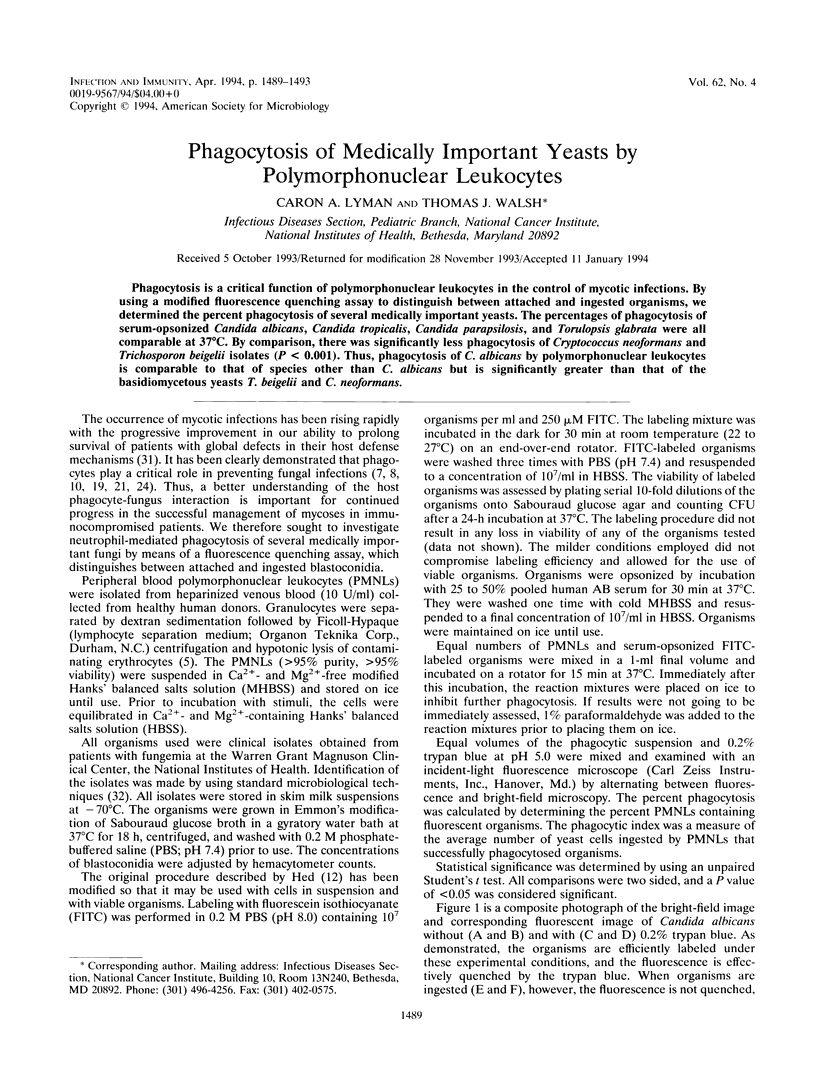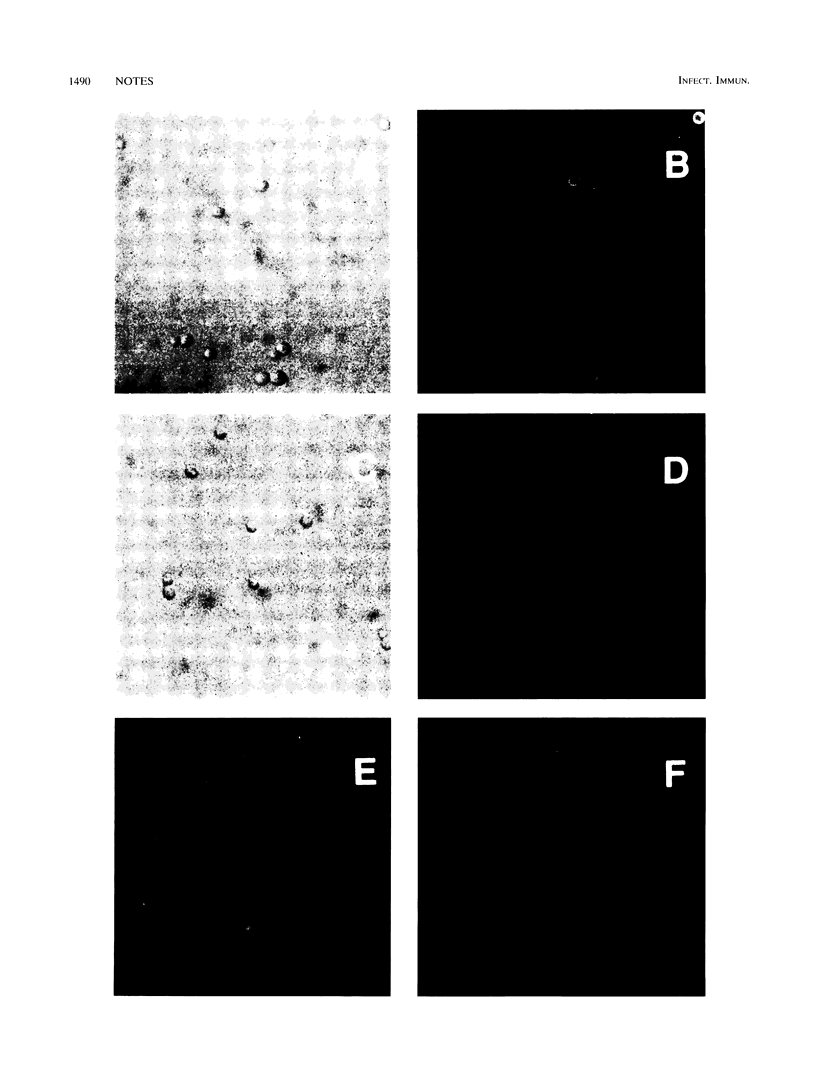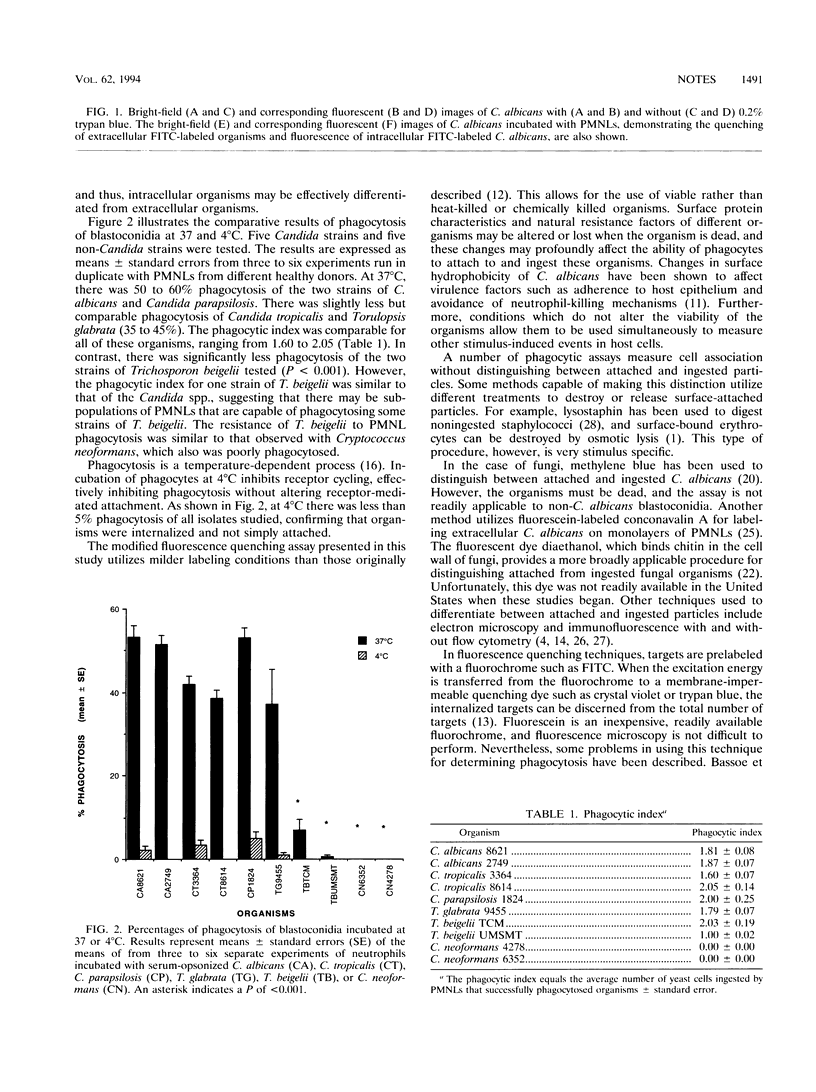Abstract
Phagocytosis is a critical function of polymorphonuclear leukocytes in the control of mycotic infections. By using a modified fluorescence quenching assay to distinguish between attached and ingested organisms, we determined the percent phagocytosis of several medically important yeasts. The percentages of phagocytosis of serum-opsonized Candida albicans, Candida tropicalis, Candida parapsilosis, and Torulopsis glabrata were all comparable at 37 degrees C. By comparison, there was significantly less phagocytosis of Cryptococcus neoformans and Trichosporon beigelii isolates (P < 0.001). Thus, phagocytosis of C. albicans by polymorphonuclear leukocytes is comparable to that of species other than C. albicans but is significantly greater than that of the basidiomycetous yeasts T. beigelii and C. neoformans.
Full text
PDF




Images in this article
Selected References
These references are in PubMed. This may not be the complete list of references from this article.
- Altman A. J., Stossel T. P. Functional immaturity of bone marrow bands and polymorphonuclear leucocytes. Br J Haematol. 1974 Jun;27(2):241–245. doi: 10.1111/j.1365-2141.1974.tb06790.x. [DOI] [PubMed] [Google Scholar]
- Bassøe C. F., Laerum O. D., Glette J., Hopen G., Haneberg B., Solberg C. O. Simultaneous measurement of phagocytosis and phagosomal pH by flow cytometry: role of polymorphonuclear neutrophilic leukocyte granules in phagosome acidification. Cytometry. 1983 Nov;4(3):254–262. doi: 10.1002/cyto.990040311. [DOI] [PubMed] [Google Scholar]
- Beck-Sagué C., Jarvis W. R. Secular trends in the epidemiology of nosocomial fungal infections in the United States, 1980-1990. National Nosocomial Infections Surveillance System. J Infect Dis. 1993 May;167(5):1247–1251. doi: 10.1093/infdis/167.5.1247. [DOI] [PubMed] [Google Scholar]
- Bjerknes R., Bassøe C. F., Sjursen H., Laerum O. D., Solberg C. O. Flow cytometry for the study of phagocyte functions. Rev Infect Dis. 1989 Jan-Feb;11(1):16–33. doi: 10.1093/clinids/11.1.16. [DOI] [PubMed] [Google Scholar]
- Bulmer G. S., Sans M. D. Cryptococcus neoformans. 3. Inhibition of phagocytosis. J Bacteriol. 1968 Jan;95(1):5–8. doi: 10.1128/jb.95.1.5-8.1968. [DOI] [PMC free article] [PubMed] [Google Scholar]
- Böyum A. Isolation of mononuclear cells and granulocytes from human blood. Isolation of monuclear cells by one centrifugation, and of granulocytes by combining centrifugation and sedimentation at 1 g. Scand J Clin Lab Invest Suppl. 1968;97:77–89. [PubMed] [Google Scholar]
- Diamond R. D. Immune response to fungal infection. Rev Infect Dis. 1989 Nov-Dec;11 (Suppl 7):S1600–S1604. doi: 10.1093/clinids/11.supplement_7.s1600. [DOI] [PubMed] [Google Scholar]
- Diamond R. D., Krzesicki R., Epstein B., Jao W. Damage to hyphal forms of fungi by human leukocytes in vitro. A possible host defense mechanism in aspergillosis and mucormycosis. Am J Pathol. 1978 May;91(2):313–328. [PMC free article] [PubMed] [Google Scholar]
- Drevets D. A., Campbell P. A. Macrophage phagocytosis: use of fluorescence microscopy to distinguish between extracellular and intracellular bacteria. J Immunol Methods. 1991 Aug 28;142(1):31–38. doi: 10.1016/0022-1759(91)90289-r. [DOI] [PubMed] [Google Scholar]
- Fromtling R. A., Shadomy H. J. An overview of macrophage-fungal interactions. Mycopathologia. 1986 Feb;93(2):77–93. doi: 10.1007/BF00437738. [DOI] [PubMed] [Google Scholar]
- Hazen K. C. Participation of yeast cell surface hydrophobicity in adherence of Candida albicans to human epithelial cells. Infect Immun. 1989 Jul;57(7):1894–1900. doi: 10.1128/iai.57.7.1894-1900.1989. [DOI] [PMC free article] [PubMed] [Google Scholar]
- Hed J. Methods for distinguishing ingested from adhering particles. Methods Enzymol. 1986;132:198–204. doi: 10.1016/s0076-6879(86)32008-1. [DOI] [PubMed] [Google Scholar]
- Heesemann J., Laufs R. Double immunofluorescence microscopic technique for accurate differentiation of extracellularly and intracellularly located bacteria in cell culture. J Clin Microbiol. 1985 Aug;22(2):168–175. doi: 10.1128/jcm.22.2.168-175.1985. [DOI] [PMC free article] [PubMed] [Google Scholar]
- Hoy J., Hsu K. C., Rolston K., Hopfer R. L., Luna M., Bodey G. P. Trichosporon beigelii infection: a review. Rev Infect Dis. 1986 Nov-Dec;8(6):959–967. [PubMed] [Google Scholar]
- KARNOVSKY M. L. Metabolic basis of phagocytic activity. Physiol Rev. 1962 Jan;42:143–168. doi: 10.1152/physrev.1962.42.1.143. [DOI] [PubMed] [Google Scholar]
- Komshian S. V., Uwaydah A. K., Sobel J. D., Crane L. R. Fungemia caused by Candida species and Torulopsis glabrata in the hospitalized patient: frequency, characteristics, and evaluation of factors influencing outcome. Rev Infect Dis. 1989 May-Jun;11(3):379–390. doi: 10.1093/clinids/11.3.379. [DOI] [PubMed] [Google Scholar]
- Kozel T. R., Pfrommer G. S., Guerlain A. S., Highison B. A., Highison G. J. Role of the capsule in phagocytosis of Cryptococcus neoformans. Rev Infect Dis. 1988 Jul-Aug;10 (Suppl 2):S436–S439. doi: 10.1093/cid/10.supplement_2.s436. [DOI] [PubMed] [Google Scholar]
- Lehrer R. I., Cline M. J. Interaction of Candida albicans with human leukocytes and serum. J Bacteriol. 1969 Jun;98(3):996–1004. doi: 10.1128/jb.98.3.996-1004.1969. [DOI] [PMC free article] [PubMed] [Google Scholar]
- Lehrer R. I., Ferrari L. G., Patterson-Delafield J., Sorrell T. Fungicidal activity of rabbit alveolar and peritoneal macrophages against Candida albicans. Infect Immun. 1980 Jun;28(3):1001–1008. doi: 10.1128/iai.28.3.1001-1008.1980. [DOI] [PMC free article] [PubMed] [Google Scholar]
- Lehrer R. I. Functional aspects of a second mechanism of candidacidal activity by human neutrophils. J Clin Invest. 1972 Oct;51(10):2566–2572. doi: 10.1172/JCI107073. [DOI] [PMC free article] [PubMed] [Google Scholar]
- Levitz S. M., DiBenedetto D. J., Diamond R. D. A rapid fluorescent assay to distinguish attached from phagocytized yeast particles. J Immunol Methods. 1987 Jul 16;101(1):37–42. doi: 10.1016/0022-1759(87)90213-4. [DOI] [PubMed] [Google Scholar]
- Melcher G. P., Reed K. D., Rinaldi M. G., Lee J. W., Pizzo P. A., Walsh T. J. Demonstration of a cell wall antigen cross-reacting with cryptococcal polysaccharide in experimental disseminated trichosporonosis. J Clin Microbiol. 1991 Jan;29(1):192–196. doi: 10.1128/jcm.29.1.192-196.1991. [DOI] [PMC free article] [PubMed] [Google Scholar]
- Morrison R. P., Cutler J. E. In vitro studies of the interaction of murine phagocytic cells with Candida albicans. J Reticuloendothel Soc. 1981 Jan;29(1):23–34. [PubMed] [Google Scholar]
- Richardson M. D., Kearns M. J., Smith H. Differentiation of extracellular from ingested Candida albicans blastospores in phagocytosis tests by staining with fluorescein-labelled concanavalin A. J Immunol Methods. 1982 Jul 30;52(2):241–244. doi: 10.1016/0022-1759(82)90050-3. [DOI] [PubMed] [Google Scholar]
- Sahlin S., Hed J., Rundquist I. Differentiation between attached and ingested immune complexes by a fluorescence quenching cytofluorometric assay. J Immunol Methods. 1983 May 27;60(1-2):115–124. doi: 10.1016/0022-1759(83)90340-x. [DOI] [PubMed] [Google Scholar]
- Sveum R. J., Chused T. M., Frank M. M., Brown E. J. A quantitative fluorescent method for measurement of bacterial adherence and phagocytosis. J Immunol Methods. 1986 Jun 24;90(2):257–264. doi: 10.1016/0022-1759(86)90083-9. [DOI] [PubMed] [Google Scholar]
- Verhoef J., Peterson P. K., Quie P. G. Kinetics of staphylococcal opsonization, attachment, ingestion and killing by human polymorphonuclear leukocytes: a quantitative assay using [3H]thymidine labeled bacteria. J Immunol Methods. 1977;14(3-4):303–311. doi: 10.1016/0022-1759(77)90141-7. [DOI] [PubMed] [Google Scholar]
- Walsh T. J., Lee J. W., Melcher G. P., Navarro E., Bacher J., Callender D., Reed K. D., Wu T., Lopez-Berestein G., Pizzo P. A. Experimental Trichosporon infection in persistently granulocytopenic rabbits: implications for pathogenesis, diagnosis, and treatment of an emerging opportunistic mycosis. J Infect Dis. 1992 Jul;166(1):121–133. doi: 10.1093/infdis/166.1.121. [DOI] [PubMed] [Google Scholar]
- Walsh T. J., Pizzo P. A. Nosocomial fungal infections: a classification for hospital-acquired fungal infections and mycoses arising from endogenous flora or reactivation. Annu Rev Microbiol. 1988;42:517–545. doi: 10.1146/annurev.mi.42.100188.002505. [DOI] [PubMed] [Google Scholar]



